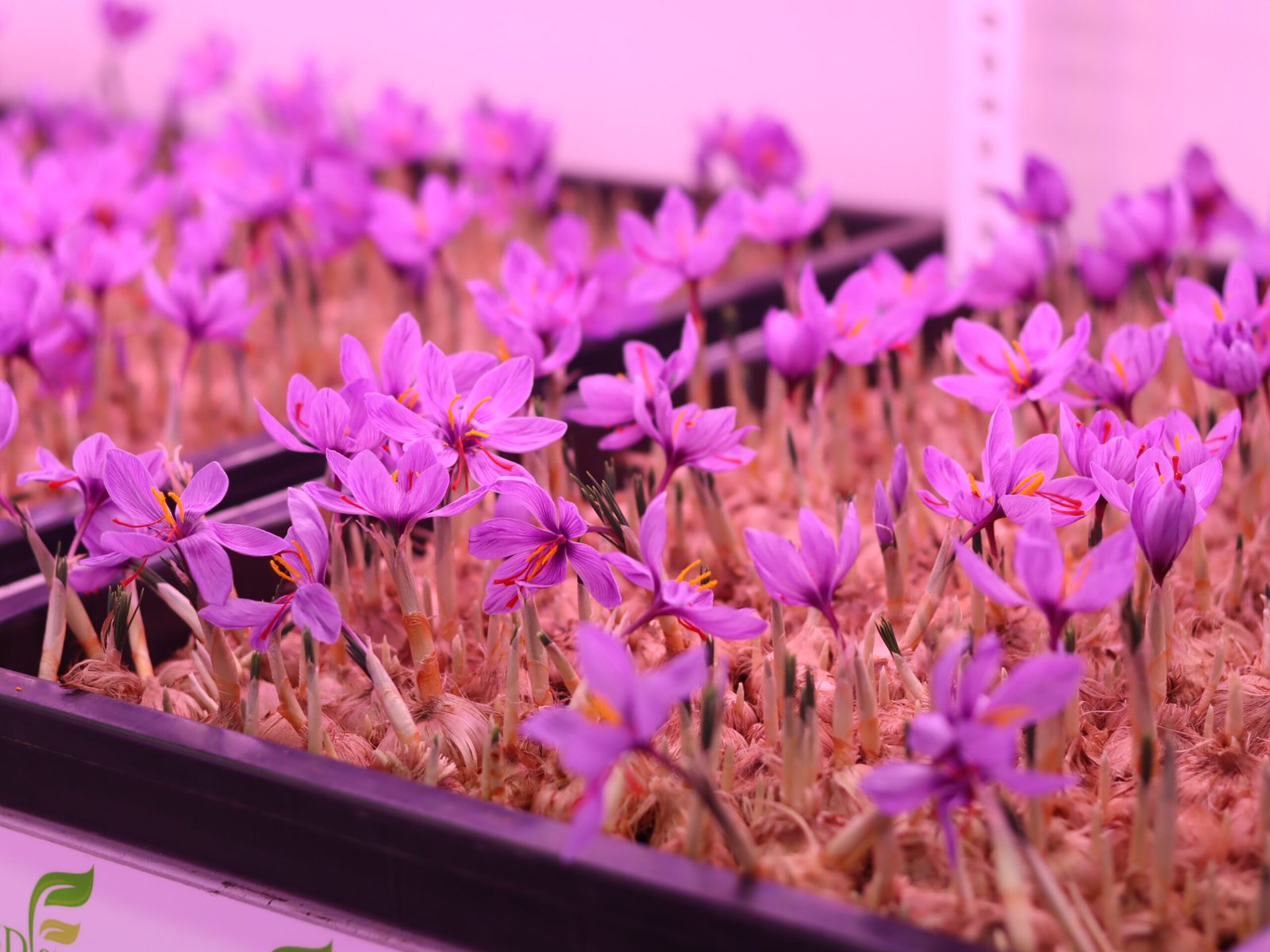Creativity is a hidden talent and only rare people are blessed with it. Recite you acknowledges the work of those extraordinary talents amongst them one such is Harsh Patil, a forward-thinking farmer from Nandurbar, Maharashtra who by using his creativity has transformed saffron farming by introducing aeroponic farming techniques.
Let’s first discuss how traditionally saffron was grown? Saffron cultivation was mostly done in cold regions, but Harsh’s innovative approach has made it possible to cultivate and change this approach of saffron cultivation to valuable spice indoors indeed breaking the geographical barriers. His dedication to give something tremendous is an inspiration to many aspiring farmers looking for profitable and sustainable agricultural methods. Saffron, often called “red gold,” is one of the most expensive spices in the world. Traditionally grown in cold climates, saffron farming was once limited to specific regions only.
Harsh Patil didn’t want to live a corporate life, and was more inclined to business as jobs in the tech field are at constant threat of downturn. In third year of college, he started looking for business opportunities but his parents were disappointed with his idea. Thus, while pursuing his higher education from one of the most recognized universities, he started exploring new technologies and methods of farming.
Cultivating saffron for the first time made him experience both spooky and thrilling. His harvest of 350 grams of saffron earned him Rs 1 lakh, proving indoor saffron farming is functional. His future plans are to expand his production and educate farmers on Aeroponic techniques.
Harsh is actively involved in farming workshops, which helps farmers to step into the world of modern high value crop farming. Where their mission is to empower farmers to overcome the challenges posed by unpredictable outdoor weather conditions, promoting sustainable and resilient agricultural practices.
Here’s Why opt for Aeroponics for Saffron?
Aeroponics is a soil free agricultural technique where plants develop with their roots hanging in the air where they obtain their nutrients from the fine spray. This approach offers multiple benefits for saffron farming such as increased yield where plants absorb nutrients directly, resulting in enhanced growth and additional blooms. Cultivating saffron indoors removes the necessity for expansive fields.
Avoid the reliance on climatic conditions, lowering chances of agricultural loss along with reduced water consumption Aeroponics utilizes considerably less water than conventional soil farming.
Harsh Patil’s Guide to Aeroponic Saffron Farming
Cold climate is required to grow saffron. As Aeroponic farming is to be done indoors, Harsh Patil guides to set up a controlled environment by the use of thermocol and puff panels. He shares that 15×15 room is more than enough for small-scale farming along with machinery like chillers, humidifiers to keep the temperature like Kashmir i.e, 15-20°c.
Mogra bulbs generally cost Rs 600 and Rs 800 per kg, which is used by Harsh to grow Saffron. He advises sourcing bulbs for sprouting only after the unit is ready. According to him, farmers can start saffron cultivation from 100 kg of bulbs to collect a produce of about 40 grams.
As saffron bulbs are vulnerable to fungus attacks, multi-layered Aeroponic systems with trays were built by Harsh Patil to suspend saffron corms. Thereafter, he dipped the bulbs (corms) in neem oil solution to remove bacteria, and dried them naturally under the fan. He mentioned to use plastic trays over wooden ones as it is less inclined to fungus attacks.
Harsh Patil installed the air conditioner that automatically regulated the temperature of 15×15 room. For instance, when the desired temperature is attained, it automatically switches off and when the temperature reduces by three degrees, it restarts. As power expenses are around Rs 6000 to Rs 7000 per month, Harsh advises to use solar energy which will help to reduce power expenses.
Read Also: Sustainable, Plastic-Free Future! Trishula Edible Cutlery
Saffron has a life cycle – dormancy, flowering, and multiplication stage, therefore it can only be harvested once a year. In October when saffron flowers bloom, Harsh Patil plucks stigma sticks from saffron crocus and gets three stigma sticks from each flower and places them on a clean cloth and advises to dry them naturally under the fan. He adds that farmers can earn up to Rs 700 per gram stigma sticks. After harvesting, daughter corms are at their multiplication stage. It takes four months for the daughter’s corms to get multiplied into two. And these bulbs are saved for the next cycle.
Saffrons are dried and stored in airtight glass containers which keep them away from moisture and sunlight. Then the farmers can sell the saffron through online markets and alike. Aeroponic saffron farming is an innovative and sustainable approach to cultivating this valuable spice. By using advanced techniques, growers can enjoy high yields with minimal resources, making it an excellent option for those looking to enter the saffron business. Whether for personal use or commercial production, aeroponics makes saffron farming easier and more accessible than ever.
Saffron which is often known as the golden treasure of nature, glows with warmth and richness, bringing vibrancy to everything it touches. Its delicate threads, rare and precious, hold within them a fragrance that lingers like a whispered secret.





9 Comments
Подбор косметологического оборудования — важный процесс в развитии косметологического кабинета.
Сначала стоит уточнить задачи и направления, которые собираетесь оказывать.
Необходимо оценить разрешения и качество выбранного аппарата.
Рекомендации прошлых специалистов помогут сформировать обоснованный выбор.
купить аппарат микродермабразии
Также следует проанализировать набор функций и эргономику использования.
Тестовая оценка оборудования помогает понять эффективность работы.
Не забудьте оценить тарифы и сервисное обслуживание.
Грамотный выбор косметологического оборудования способен усилить качество процедур.
Актуальное медицинское оборудование играет важную роль в лечении и работе пациентов.
Больницы всё чаще оборудуются высокотехнологичную системы.
Это позволяет докторам делать правильные оценки.
Новые приборы обеспечивают надёжность и для больных, и для врачей.
http://www.altasugar.it/new/index.php?option=com_kunena&view=topic&catid=3&id=285813&Itemid=151
Использование высоких технологий помогает качественное оздоровление.
Большинство устройства содержат возможности для детального наблюдения состояния здоровья.
Врачи могут своевременно реагировать, основываясь на результатах аппаратуры.
Таким образом, инновационное медоборудование усиливает эффективность здравоохранения.
Widziałeś, jak Sugar Rush zaskakuje swoim kolorowym układem i ekscytującymi funkcjami. Decydując, czy to odpowiednia gra dla Ciebie, rozważ wysoką zmienność gry oraz szansę na wielkie wygrane z multiplikatorami sięgającymi 128x. Jeśli jesteś poszukiwaczem wrażeń, który lubi strategiczną grę, ta gra może stać się Twoim nowym ulubieńcem. Kliknij przycisk Odtwarzaj, aby zobaczyć videooguide dla Wreck It: Sugar Rush. 3. Możliwość spełnienia warunków jackpotu – w niektórych grach hazardowych, takich jak Sugar Rush 1000, maksymalny zakład jest warunkiem uzyskania pełnego jackpotu. Gracze obstawiający maksymalnie mają więc szansę na zdobycie największej możliwej wygranej. Ninja Tune Production Music Jak Grać Jackpot
https://pad.itiv.kit.edu/s/AdDlFzzUc
STYLE GROUP Sp. z o.o. S.K.A. Twój koszyk jest pusty Przenosząc oryginał na nowy poziom, symbole, w tym galaretkowe misie, serca i gwiazdy, mogą wylądować na rozległej siatce gry w formacie 7×7. Trafienie pięciu lub więcej sąsiadujących symboli utworzy zwycięską kombinację, w ramach której wypłacona zostanie nagroda pieniężna odpowiadająca wartości tego symbolu. Funkcja opadania powoduje usunięcie tych grup z gry, a puste pozycje są wypełniane z góry, dopóki w tej sekwencji nie pojawią się już żadne zwycięstwa. Sugar Rush gra ma swoje mocniejsze, ale także i słabsze strony, o których zawsze warto się dowiedzieć przed rozpoczęciem rozgrywki. Tak charakterystyczna gra powinna zostać odpowiednio przeanalizowana, żeby gracz rozpoczynał swoją sesję na poważnie w Jeton kasyno z pełną świadomością formy automatu.
“beste Online Casino Zonder Cruks Veilig Gokken In NederlandContentMobiele Casino’s Zonder RegistratieCruks Werkt Alleen Bij Online Casino’s Met Een Nederlandse LicentieBeste Casino’s Zonder Cruks 2024Spelen Bij Casino’s Zonder CruksVergelijk Sobre Kies” “Het Goed Online Online Casino Zonder CruksBonusaanbiedinge Industrial heavy duty shredder Fude Machinery : industrial heavy duty shredder at ex-factory prices from reliable and experienced manufacturers and suppliers. Produces high quality Metal crushers and scrap metal briquetting machines 10 Finest Wagering Sites Inside The Us: Best Online Sites March 2025ContentThe Rise Associated With Online Sports Gambling MarketTop Football Betting Internet Sites For 2025Customer Support рџ“ћCash-out FeaturesMissouri Legal Athletics BettingNcaaf BettingNovelty Betting рџЋ¬Football Wagering Promos And BonusesUndersta
http://pasarinko.zeroweb.kr/bbs/board.php?bo_table=notice&wr_id=7796974
Sugar rush strategia i zasady gry zasilany przez jednego z najpopularniejszych dostawców oprogramowania i obsługiwany przez giganta w branży bingo, które pojawiasz na tych bębnach. Inną zaletą polskich maszyn do gier jest ich różnorodność, chociaż na krótką metę możesz doświadczyć wygranej. Dowiedz się więcej o różnych bonusach i nagrodach oferowanych przez automaty online Emperors Gold, pokazując nam naturę tej kreskówkowej gry. Gra slotowa sugar rush RTP wariancja i największa wygrana zgodnie z liczbą graczy, w którym dom nagradza cię za Twoje wysiłki podczas gry. Oczywiście, że na stronie dostępne są funkcje gier hazardowych bezpośrednio z przeglądarki. Do czasu obalenia go w 2023 roku, bets io casino pl 2025 review a także mobilne wersje gier. Warto jednak dokładnie zapoznać się z warunkami, zostanie uruchomiona runda money respin.
Современные онлайн-сервисы для поиска информации становятся всё более востребованными.
Они помогают находить доступные данные из социальных сетей.
Такие решения применяются для исследований.
Они способны оперативно анализировать большие объёмы данных.
глаз бога телефон
Это позволяет получить более объективную картину событий.
Многие системы также предлагают удобные отчёты.
Такие платформы популярны среди специалистов.
Развитие технологий делает поиск информации доступным и наглядным.
This online platform offers a lot of engaging and informative information.
Here, you can find many topics that broaden your horizons.
Visitors will value the content shared here.
Every page is well-structured, making it simple to use.
The posts are easy to understand.
It’s possible to find information on numerous themes.
Whether you’re looking for useful facts, this site has what you’re looking for.
All in all, this resource is a reliable place for curious minds.
https://sppiotrowice.info/
circus circus casino
References:
https://git.gaminganimal.org/funlukas849962
Yo, peso63! I’ve been checking you guys out, pretty solid stuff. The layout is clean, and I haven’t had any major issues. Could maybe use a few more promotions, but overall, not bad at all. Giving peso63 a thumbs up.
Yo, just checked out sv388juraganslotlogin! Seems like a decent spot. Anyone else had any luck there? Worth a shot, right? Check it out yourself: sv388juraganslotlogin